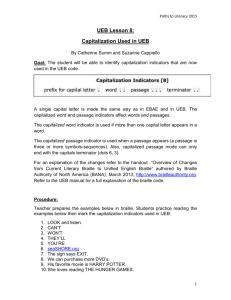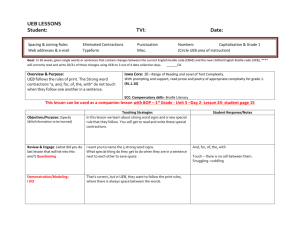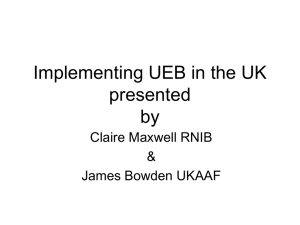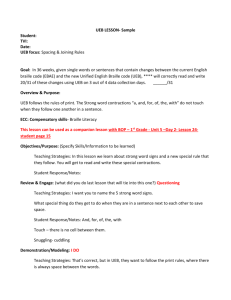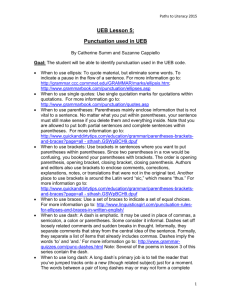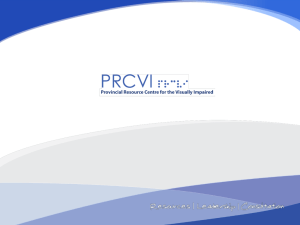Braille users views on UEB
advertisement
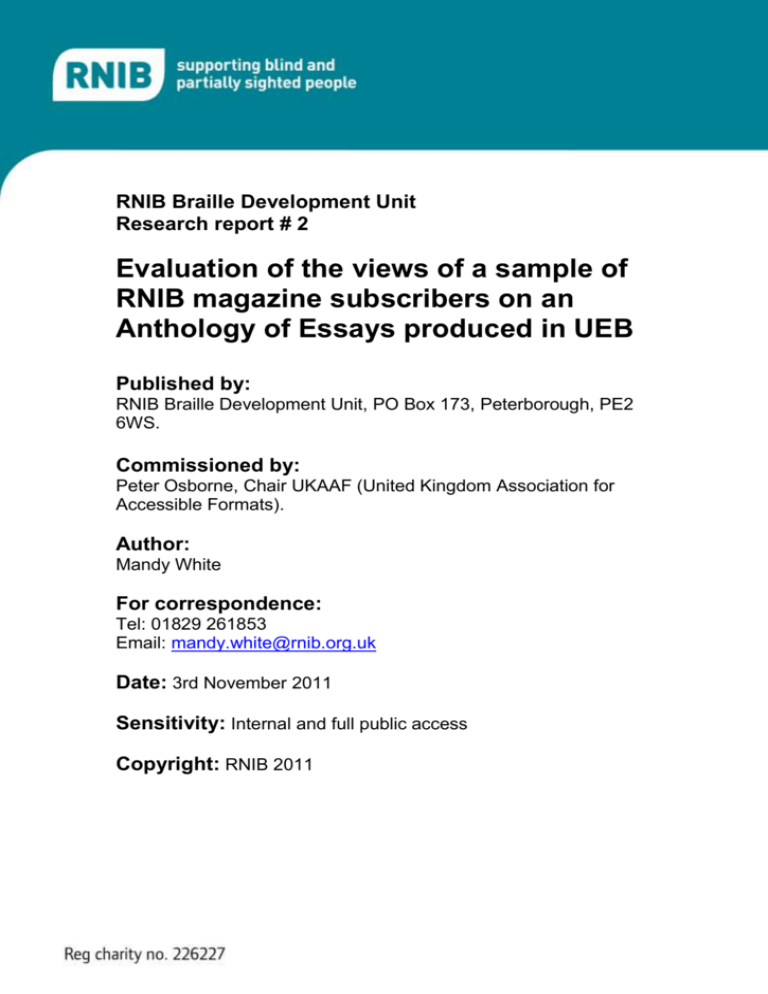
RNIB Braille Development Unit Research report # 2 Evaluation of the views of a sample of RNIB magazine subscribers on an Anthology of Essays produced in UEB Published by: RNIB Braille Development Unit, PO Box 173, Peterborough, PE2 6WS. Commissioned by: Peter Osborne, Chair UKAAF (United Kingdom Association for Accessible Formats). Author: Mandy White For correspondence: Tel: 01829 261853 Email: mandy.white@rnib.org.uk Date: 3rd November 2011 Sensitivity: Internal and full public access Copyright: RNIB 2011 © RNIB 2011 Citation guidance: White, M. (2011). Evaluation of the views of a sample of RNIB magazine subscribers on an Anthology of Essays produced in UEB. RNIB Braille Development Unit, Peterborough. Acknowledgements: Many thanks to all the braille readers who read the anthology and contributed their views on UEB to the research team Thanks also to Sarah Home and Heather Cryer for editorial input. 2 © RNIB 2011 Evaluation of the views of a sample of RNIB magazine subscribers on an Anthology of Essays produced in UEB RNIB Braille Development Unit Prepared by: Mandy White (Project Manager - Braille) Table of Contents A. Executive Summary ........................................................... 5 B. Introduction ........................................................................ 5 C. Method .............................................................................. 6 C.1 Design .......................................................................... 6 C.2 Participants .................................................................. 6 C.3 Demographic information ............................................. 6 C.5 Materials ...................................................................... 7 C.6 Procedure .................................................................... 7 D. Results .............................................................................. 7 D.1 Question 1 .................................................................... 7 D.2 Question 2 .................................................................... 7 D.3 Question 3 .................................................................... 8 D.4 Question 4 .................................................................... 8 D.5 Question 5 .................................................................... 9 D.6 Question 6 .................................................................... 9 D.7 Question 7 .................................................................. 10 D.8 Question 8 .................................................................. 10 D.9 Question 9 .................................................................. 12 D.10 Question 10 .............................................................. 12 D.11 Question 11 .............................................................. 12 D.12 Question 12 .............................................................. 13 D.13 Question 13 .............................................................. 13 D.14 Question 14 .............................................................. 14 E. Conclusion ....................................................................... 15 3 © RNIB 2011 Appendix 1 - Full list of comments in answer to question 13 ....... 17 a) The History of UEB ....................................................... 17 b) Issues around Increased size of documents in UEB ..... 17 c) Training and Reference Manuals .................................. 17 d) The proposed audience for UEB................................... 18 e) UEB/SEB or both .......................................................... 18 f) Consultation and timescale............................................ 18 g) Legacy Material ............................................................ 18 h) Rationale for the change............................................... 19 i) Changing just the technical code ................................... 19 j) Cost and availability ....................................................... 19 k) Capital letters ................................................................ 19 Appendix 2 - Full list of comments in answer to question 14 ....... 20 a) General comments about UEB implementation - positive ......................................................................................... 20 b) General comments about UEB implementation - negative ......................................................................................... 20 c) User Feedback ............................................................. 22 d) Reference and Training Material................................... 22 e) Speed of Reading ......................................................... 22 f) Increased space taken by UEB...................................... 22 g) SEB/UEB or both .......................................................... 24 h) Consultation and timescales ......................................... 24 i) Capital Letters ............................................................... 25 j) Specific Coding and layout observations ....................... 25 k) The proposed audience for UEB ................................... 26 l) General Observations on the braille code ...................... 27 m) Spelling........................................................................ 27 n) Affordability. .................................................................. 27 4 © RNIB 2011 A. Executive Summary This piece of research was commissioned by The UK Association of Accessible Formats (UKAAF), the independent standards organisation in the UK. They were considering the possibility of adopting the Unified English Braille code (UEB) in the UK and wanted to know more about the views of the 'silent majority' of braille users. An anthology of the winning essays from a Global braille essay competition was produced in UEB and sent to all the subscribers to an RNIB magazine. A week later the recipients were all contacted by phone and asked a number of questions about themselves, their braille use and what they thought of the UEB anthology. The research revealed that 73% of this cross section of regular braille readers had heard of UEB. 37.9% could read it without any difficulty. A further 49.5% could read it but more slowly than usual. 12.6% could read it but found it difficult. No one said that they were unable to read it. 67% of the participants said that the braille coding didn't cause any problems or that they noticed some differences but soon got over them. Of those people who had problems with the coding the major issue was the removal of contractions followed by the changes in punctuation coding followed by the removal of sequencing (in UEB wherever there is a space between words on the printed page there must be one in braille). Participants in the research had been given minimal information on the reasons for the proposed introduction of UEB and they also had not been given any information on the actual code changes. There were therefore two qualitative questions dealing with both the respondents specific queries on UEB and their personal views on UEB at the end of the questionnaire. There was a range of comments from people both in support of UEB and those who didn't see the need to change. The main objection to UEB was the increased space that it took. The results of this research were included in a paper to the UKAAF board in order to assist them in making a decision on the adoption of UEB in the United Kingdom. B. Introduction The UK Association of Accessible Formats (UKAAF) was keen to gather representative views of braille users on the new Unified English Braille Code (UEB). In 2008 the Braille Authority of the UK (BAUK) had undertaken a consultation of braille users. The 5 © RNIB 2011 consultation pack was sent out to over 4,000 users, producers, intermediaries and stakeholders and 470 responses were received back. Of those people responding 347 did not want to see UEB adopted in the UK (76%). BAUK therefore recommended that UEB should not be introduced at that time. Shortly after the consultation BAUK merged with several other organisations to form UKAAF. UKAAF returned to the question of the introduction of UEB in 2011. RNIB had produced some research (Phillips A. and Beesley L. (2011) Braille Profiling Project) which suggested that the so called 'silent majority' would be more likely to support UEB and less likely to respond to the type of consultation undertaken by BAUK in 2008. UKKAF therefore commissioned this piece of research where a sample cross section of braille users were identified and all of them were then contacted and asked their views on UEB. C. Method C.1 Design The interview questions were designed to reflect both a quantitiative and qualitative approach. The first 12 questions had a specified choice of responses and the last two questions gave participants the opportunity to discuss more fully their views on the sample documentation and UEB more generally. Whilst emerging themes are discussed in the main body of the report, Appendix one and two list the respondents views in full, to these last two questions. C.2 Participants RNIB distribute a number of monthly magazines and the subscribers of one particular magazine were identified as being likely to be interested in the sample material that had been sourced in UEB. The distribution list of over 200 was reduced to 165 by excluding Those with no telephone number Organisations People living abroad People who had expressed a desire not to be contacted C.3 Demographic information The demographic range of the group is as follows Under 19 0% 19 - 39 4.9% 6 © RNIB 2011 40 - 64 44.7% 65 + 49.5% Not disclosed 1% C.5 Materials A sample of UEB was sent to all participants. The material was a collection of essays written by braille users on how braille had changed their lives. The essays were written by the winners of a Global competition which is run annually. The essays were all written or had been translated into English however the names of the authors did occasionally cause some confusion. C.6 Procedure 165 people were sent a copy of the Anthology of Essays. Just over a week later the RNIB telemarketing team started to contact the participants by phone. All possible interviews and call backs were completed within 10 days. By this time, the team had managed to secure the views of 107 participants D. Results In the results section, the answers to the first 12 questions are given in the form of a table showing both the number of people choosing a particular answer and the percentage of the respondents choosing a particular answer. The results section for questions 13 and 14 summarise the themes covered by the respondents and the actual recorded responses are listed in Appendix 1 and 2. D.1 Question 1 Before receiving this anthology, had you heard of the Unified English Braille code? Answer Options Yes No Response Response Percent Count 72.9% 78 27.1% 29 107 respondents answered this question D.2 Question 2 Did you read the introduction to the anthology in Standard English Braille? 7 © RNIB 2011 Answer Options Yes No Response Response Percent Count 93.5% 100 6.5% 7 107 respondents answered this question D.3 Question 3 Did you read any of the essays in the anthology? Answer Options I didn't read any of the document I read the introduction but didn't read the essays I read part of an essay or part of a few essays I read one essay or a few essays I read most of the essays I read all of the essays Response Response Percent Count 2.8% 3 2.8% 3 12.0% 13 32.4% 22.2% 27.8% 35 23 30 107 respondents answered this question D.4 Question 4 Why did you only read the introduction? Respondents were only asked this question if they responded to Question 3 by answering “I read the introduction but didn't read the essays”. Answer Options I didn't have time to read the essays I wasn't interested in the subject matter I wasn't interested in trying UEB I was put off by the idea of capital letters I was put off by the idea of reading Response Response Percent Count 0.0% 0 0.0% 0 33.3% 1 0.0% 0 0.0% 0 8 © RNIB 2011 a different Braille code Other (please specify) 66.7% 2 3 respondents answered this question 104 respondents skipped this question “Other” answers were: I didn't really understand what it was about. It's like music and it doesn't say what it is. D.5 Question 5 Why did you only read part of an essay? Respondents were only asked this question if they responded to Question 3 by answering “I read part of an essay or part of a few essays”. Answer Options I didn't have time to read any more I wasn't interested in the subject matter I wasn't interested in trying UEB I was put off by the capital letters I was put off by differences in the Braille code I found the Braille difficult to read Other (please specify) Response Response Percent Count 42.9% 6 21.4% 3 21.4% 0.0% 3 0 28.6% 4 7.1% 21.4% 1 3 “Other” answers were: I am a transcriber I'm not a huge Braille reader anyway. I was put off by the bulkiness of it. 14 respondents answered this question 93 respondents skipped this question D.6 Question 6 Could you read the Braille in which the essays were presented? (Please choose the option which is closest to your experience) 9 © RNIB 2011 Answer Options Response Response Percent Count Yes, I could read it without any difficulty Yes, I could read it but more slowly than usual Yes, I could read it but I found it difficult No, I couldn't read it 37.9% 39 49.5% 51 12.6% 13 0.0% 0 103 respondents answered this question 4 respondents skipped this question D.7 Question 7 Did you encounter any problems with the Braille coding when reading the essays? (Please choose the option closest to your experience) Answer Options The Braille coding didn't cause me any problems I noticed some differences to the Braille coding I'm used to, but I got over them I didn't understand some of the coding, but I could understand the gist of the text Some of the differences in Braille coding confused me The differences in Braille coding made it impossible to understand the text Response Response Percent Count 14.6% 15 52.4% 54 21.4% 22 10.7% 11 1.0% 1 103 respondents answered this question 4 respondents skipped this question D.8 Question 8 If you encountered problems with the Braille coding, were any of the following aspects of the coding difficult for you? 10 © RNIB 2011 Answer Options Introduction of capital letters Removal of sequencing (where small words such as and/for used to follow without spacing in between) Removal of contractions Changes in punctuation coding Other (please specify) “Other” answers were: Response Response Percent Count 25.0% 17 42.6% 29 58.8% 48.5% 26.5% 40 33 18 Comments on Specific Coding Issues I did not like the ellipsis Don't like the Brackets (x3) Three full stops at the end of a line, I didn't understand what they were I could not understand a 3 lower d sign at the beginning of a line At the beginning and the end there were a dot 5 and then a gh sign which I didn't understand The titles, where brackets are used, looked like pause signs in music. More space and brackets codes caused problems I could not work out the name of the first contributor (Jönsson) Extra dots get in the way The first essay has a sign that I noticed "In the Borderlands" during part of it at the end of one of the paragraphs the paragraph ends "I now have the words in my fingers". Between the two paragraphs there are 3 full stops taking in a new line and starting a paragraph. Why is this? Why does this system not use the sequential words as in standard Braille? General issues I found the UEB rather strange. For me constant change is a problem Did not like changes but would get used to it Would have liked more explanation about changes Concern as to how other contractions would be coded 68 respondents answered this question 11 © RNIB 2011 39 respondents skipped this question D.9 Question 9 Finally, a few questions about you: Can you tell me which age group you fall into? Answer Options under 19 19-39 40 - 64 65+ Prefer not to say Response Response Percent Count 0.0% 0 4.9% 5 44.7% 46 49.5% 51 1.0% 1 103 respondents answered this question 4 respondents skipped this question D.10 Question 10 How long have you been reading Braille? Answer Options less than 1 year 1 - 5 years 6 - 20 years 21 - 40 years over 40 years Response Response Percent Count 0.0% 0 1.9% 2 4.9% 5 21.4% 22 71.8% 74 103 respondents answered this question 4 respondents skipped this question D.11 Question 11 How often do you read Braille? Answer Options daily weekly every month less often Response Response Percent Count 88.3% 91 8.7% 9 1.9% 2 1.0% 1 103 respondents answered this question 12 © RNIB 2011 4 respondents skipped this question D.12 Question 12 What types of material do you read in Braille? Answer Options labels and lists leisure books such as novels factual books such as cooking, gardening or travel newspapers magazines private correspondence (letters, bills etc) work related documents study materials personal notes technical Braille codes (science, maths, computing) foreign language Braille codes Other (please specify) Response Response Percent Count 73.8% 76 64.1% 66 62.1% 64 5.8% 99.0% 6 102 75.7% 78 17.5% 21.4% 63.1% 18 22 65 24.3% 25 20.4% 32.0% 21 33 103 respondents answered this question 4 respondents skipped this question D.13 Question 13 Do you have any questions about UEB which you think should be answered in the FAQs? Participants had many suggestions for subjects which should be included in a Frequently asked questions list. For a full list of suggestions, please refer to appendix one. In summary the topics are as follows The history of UEB - when was it formed and what was the idea behind it? What are the reasons for change and what are the main differences? Why can't we just change the technical code? Why can't we have UEB without the capital letters? Will UEB be more expensive, will it mean you can produce more braille? 13 © RNIB 2011 Why has it been necessary to design UEB in a way that makes it much more bulky eg. dropping some contractions and increasing the number of cells used for punctuation? What kind of training will be available in UEB and what reference materials will be produced? Clarity on who the change is for. Some braille users feel that the change is for the benefit of transcribers/teachers/software manufacturers etc to the detriment of the general user. Clarity on whether UEB will replace SEB or whether they will run along side each other and what this means for legacy material. What is the plan for consideration of UEB, what is the process and what are the timescales? 70 respondents answered this question 37 respondents skipped this question D.14 Question 14 Do you have anything else you would like to say about UEB? Nearly 90% of participants took the opportunity to answer this question. The full list of feedback is contained in appendix 2 of this report. There were comments both in support of the code and against it. .A summary of the key themes are as follows: There was a range of comments in support of UEB. Most commented on the fact that they found it easier than they thought it was going to be and that the differences were not significant. They felt a unified system made sense and recognised the benefits for users of the future. Those who did not like UEB were very happy with the current code, couldn't see the benefits of changing it and a number did not want to have to learn anything new at this late stage in life. Those who disliked UEB had specific objections. By far the greatest number of comments were received on the increased space taken by UEB. This would mean more braille to carry around, more shelving space required, more paper, more expense and would be detrimental to the environment. Participants felt that the increased number of cells taken by UEB would also have a negative impact on the speed of reading. They felt that the introduction of capitals was unnecessary and also a waste of space. 14 © RNIB 2011 They made specific observations on coding. Some symbols were confusing and again the increased space taken by punctuation was a negative aspect of the code. They were concerned that UEB would be more expensive to produce, People again pointed out the different types of user and how UEB might impact on them in different ways. New learners would find it easier but people currently learning would find it a demotivating. Producers would like UEB but current users (particularly older people) would not Some people felt it might improve people's spelling There was confusion as to how the code might be implemented and whether it would run alongside SEB and if it didn't how would new users access all the stocks of SEB braille that we have in the library etc. People suggested courses and reference sheets for learning the new code, maybe running magazines in UEB and SEB alongside for a few editions. In terms of a decision on adoption one person said we needed a lot more discussion and didn't want to be 'railroaded' another urged us to wait on a decision by the USA and another would appreciate a definitive decision and early implementation 95 respondents answered this question 12 respondents skipped this question E. Conclusion In conclusion, this piece of research set out to establish a representative view of a sample of braille users on reading UEB. The sample group did not receive any prior instruction and only a very basic summary of the aims of UEB and the code changes in literary braille. 73% of the sample group had previously heard of UEB and 27% hadn't. 40% could read the braille without any difficulty and 49.5% could read the braille but more slowly than usual. The most common problem identified was the removal of the 9 contractions, followed by changes in punctuation coding and then the removal of sequencing. Braille readers took the opportunity to suggest a range of subjects which should be included in a Frequently Asked Questions List. These questions formed the basis of the FAQ document which is now available from UKAAF. Nearly 90% of respondents went on to talk more specifically about their views on UEB. There was a 15 © RNIB 2011 range of comments from people both in support of UEB and from those very happy with the current code, who didn't see the need to change. The main objection to UEB was the increased space that it took. There were many other valuable observations which were all included in the report presented to the UKAAF board at the end of October 2011. The report was to assist the members in their decision as to whether to adopt UEB within the UK. 16 © RNIB 2011 Appendix 1 - Full list of comments in answer to question 13 Do you have any questions about UEB which you think should be answered in the FAQs? a) The History of UEB When was UEB formed and what is the idea behind it? b) Issues around Increased size of documents in UEB Why is UEB designed in a way that makes it more bulky? Do you not think that this will be detrimental to the environment? It takes up so much more space and it is expensive to produce and why, I thought, that RNIB were trying to change everyone over to audio. What about working people who carry books and documents around for their work? UEB is going to double their load. Why, in these days of trying to save the environment, are you introducing something that will use more paper? Why do contractions take up more space? Why are contractions being removed when they reduce space and UEB is longer? Can UEB be translated from Chinese characters? Why waste space? In the present climate where we are trying to improve on our carbon footprint how can you justify the change when it is going to take more space and more volumes? This would mean more trees needed, more transport and more shelving space. For good Braille users would you want the Braille extended by omission of certain signs like the "ally"? Does it use up more space than the Standard English Braille? c) Training and Reference Manuals Will there be any form of training to learn UEB? Will there be a leaflet outlining the changes? Will there be some kind of reference book so that we can look up things that we haven't come across before? Will there be a booklet, similar to Footprints, to explain simply the differences? I think we need a reference book to refer to. 17 © RNIB 2011 Will there be an up to date reference tutor where you can look up new signs? Is there going to be a key for the suggested differences. Where could I find listings of new codes? d) The proposed audience for UEB Who is it envisaged the UEB would be aimed at? If UEB is adopted will this be right across the board? Do you not think that this is possibly making it easier for the Braille producers but not taking into account the views of Braille users? Would the use of UEB encourage non Braille users to learn Braille? e) UEB/SEB or both Is there a plan to replace Standard English Braille or will it be an extra? Why bother? I have slight learning problems, would standard Braille still be available? Do you not think that having two different codes will be confusing for new learners? I am a Braille teacher and if, for example, they learn the word "able" as an "a" and then the contraction for ble and then they come across it as wholly spelt out it will be confusing? Would medicines and prescriptions be labelled in UEB? f) Consultation and timescale Is this definitely going ahead or do we Braille users have any say in it? Is it going to be introduced or do we have a say in it? If RNIB are planning to change how soon are they intending to implement it? g) Legacy Material If children are learning UEB how will they access old stock? Will they have to learn both UEB and Standard English Braille? Experienced Braille reader’s, would not have a problem, but what would happen to original book collections? What is going to happen to existing stock? There seem to be people who are so determined to get this changed. Why? 18 © RNIB 2011 If children start learning UEB what happens to all the books? Why mess around with something that's worked for such a long time? If it works why change it? What will happen to existing stock? Won't it be confusing for people who learn UEB if they come across books in Standard English Braille? h) Rationale for the change I understand the need for change with technical Braille but why change the rest? What are the key advantages of UEB? What are the main differences? Why reduce the contractions? i) Changing just the technical code Could we not leave Braille alone and just change it for technical Braille? Why can't Standard English Braille be left alone for every day Braille and UEB introduced just where it is practical, for example, for technical Braille? j) Cost and availability Will it be more expensive to produce? If this is implemented and Braille was easier to produce will more literature be published in Braille? k) Capital letters Why have you introduced capital letters? Why do they need to use so many capitals and spacing? 19 © RNIB 2011 Appendix 2 - Full list of comments in answer to question 14 Do you have anything else you would like to say about UEB? a) General comments about UEB implementation - positive I was worried that I might have to learn a new Braille code but now realise I would not find it difficult. As a long term Braille user I found the UEB fairly easy to adapt to. (X4) If someone was learning Braille from scratch I think it could be easier. (X2) I got on all right with the UEB but not sure if it would be very useful. I did not find the UEB Braille very different from standard Braille. I think anything that makes Braille more available and accessible is a good thing. I do think we need to move forward and I think that UEB will make it easier to learn Braille. I actually got on with it better than I thought I would and it has encouraged me to read more Braille than I have been recently. I think it’s about time, there are so many different Braille codes out there it would be nice to have just the one Braille code for users, especially if you are a new Braille user. I believe it's the future and if young people will find it easier then we must go with it. I didn't have any real problems reading it. I feel very positive about UEB. I found the UEB very comfortable to read. I am in favour of UEB I think it makes more sense to have a unified system and you soon get used to it. I have pen friends in other countries that already use it so I am used to it and I haven't encountered any problems. I was pleasantly surprised by it and think that it does have a certain logic to it. I didn't really encounter any problems. It would be a good idea if everyone used the same b) General comments about UEB implementation - negative I don’t think Braille needs any changes. (X2) 20 © RNIB 2011 I am strongly against the changes in capitals and contractions I found the UEB rather cumbersome and not very enjoyable to read I feel very strongly that Braille is something I've grown up with. It is my first language and I feel emotionally attached to it. I think it is a real shame if I can't have the books I want in the Braille I've grown up with in my own country. I also feel that writing my journal in Braille makes it more personal and I like the choice and the opportunity to use Braille. I use Standard English Braille to check my spellings and UEB feels like a 2nd language. It doesn't feel like my own. Would people be prepared to start spelling like Americans? I also do not like the way it's been brought to us. I could have missed it if the TO hadn't explained it to me. The anthology should have had a covering letter with it .I want Braille treated as the function it is. It is my normal way of doing normal stuff. Language evolves and Braille should not be changed by the powers that be. It is a form of language expression and it should be treated with respect. If UEB is introduced it should be introduced very gently. Mr X is blind and deaf and said he prefers the standard Braille system. I am not really interested in UEB I do not see the need to change from the Braille that we use at the moment to UEB. Perhaps it’s my generation, I'm 83 and I know a lot of people my age that do not like the UEB either. I really cannot see how it is going to make it easier to learn. Standard English Braille is logical and it seems as if UEB is taking away that logic. I don't understand why double letters have had to change. There seem to be people who are determined to get this changed and I don't understand why. I would not want to change to UEB at this stage in life. I found the UEB very difficult to read and am not keen on the changes. It seemed to me that it was a step backwards to Grade 1 Braille rather than Grade 2 as some of the words and phrases were not contracted I wouldn't want to re-learn anything at my age now and I don't really like changes. I found the whole thing more irksome than difficult. I don't like the capital letters; I don't like the loss of contractions or the congestion of signs. I was happy as it was I think new 21 © RNIB 2011 Braille users would find it harder to use and it’s more cumbersome the way it’s printed. I personally do not like it. I didn't come across any problems but I do think if something works why change it? It's rubbish - get rid of it. I am not willing to try it and am quite happy with what I learnt at school c) User Feedback I would hope that the comments and responses of Braille users are acted upon. d) Reference and Training Material Firstly we would need a training/information sheet with a table on the left stating the Standard English Braille and then a column on the right giving the UEB alternative. I think there should be courses for us wrinklies to help us get used to it gradually. Maybe a magazine to run alongside other RNIB magazines which explains the differences I think it would have helped if we had been given some instructions to tell us what the signs were as we went along. I couldn't make out the name of the first contributor. e) Speed of Reading I found the UEB Braille slowed me down and cannot see any advantages with it. I don’t like it! I do think that it is slower to read because you cannot get so many words on each line and for people like me who have arthritis in the shoulders this makes it more difficult to read for long. It feels like we are taking a step backwards. This is more bulky and it takes longer to read. A lot of symbols and words have doubled in size e.g. ally is now 4 cells instead of 2. f) Increased space taken by UEB I feel that UEB is going backwards. It is like converting back to Grade 1 Braille. It takes up so much space and I think Braille should be as compact as possible. (X3) I think capital letters and commas which take more space make UEB more bulky. I wasn't expected to put capital letters in when I was at school. I think that Braille should be as compact as possible but the UEB is using huge amounts of extra cells. (X2) 22 © RNIB 2011 I don't accept that it will make it easier to learn as it is more bulky and therefore it takes longer to read. I think it will be so bulky. ally, for example, takes 4 cells instead of 2. Braille is bulky enough already. I know you have to learn to change, but some of the changes suggested in UEB I do not see the reason for. You have reduced the spacing but now the new bracket signs take up more space than the old lower case g which was used previously. I would rather stay with the old style Braille as it’s more compact than the UEB. The reading material excluding the punctuation is no different really to the old Braille. I've been reading Braille for over 60 years, I didn't find the old Braille difficult and I thought that you had reached the maximum amount of punctuations and abbreviations. I don't see why it’s necessary to change it. It will obviously be more bulky and Braille books are bulky enough already. I am a language teacher and carry a lot of books and documents around as it is and if I had to carry them around in UEB it would be very difficult for me. I work in a school that has a VI unit and the class knew nothing about UEB. I think it will take more space and be more costly. The word "able" for example takes up 2 spaces in Standard English Braille but 4 spaces in UEB. Surely this is more costly and more expensive to produce. I am just concerned about the space it will take up. It will obviously take more paper to produce and therefore be more expensive and be detrimental to the environment. I feel UEB makes Braille longer and am not sure there is a need to change it. I feel that UEB is longer [more paper] and Braille should be left as it is. The benefits outweigh the extra bulk. It's a shame we have lost the sequencing but I understand why. I think it will take up much more space and I think it is totally unnecessary to put certain words out in full. If changes like symbols etc. were made to print there would be an outcry. I thought that the country was trying to save the planet but with this new UEB it will take up more space as a lot of the contractions have gone and the spacing is different. It will mean more trees needed, more transport costs and more shelving space. 23 © RNIB 2011 I don't think it will encourage people to use it and I think the way that words are spelt out rather than using contractions makes it a lot more bulky. Surely it would be better to make it less bulky? UEB takes up more space on the paper than what we are used to. I understand the point of making just one Braille that is easy for everyone to use but I don't think that’s the case. I don't like the idea of extending Braille. Braille should be more concise and not extended. It shouldn't be made more wordy. It should be made shorter to read. I have never found any ambiguities of meaning because once you've learnt the rules you've learnt it. However, I am not keen on UEB because it is clumsy and it will be more bulky than it is already. I particularly dislike the oblique "/" as it uses 2 cells which is unnecessary and the brackets are dreadful. g) SEB/UEB or both Would Standard English Braille be phased out? I feel that as a Braille teacher it is difficult enough to explain the rules of Standard English Braille but if you add UEB new learners will not know what is right for which kind of Braille. The UEB took up more space, am an avid reader so persevered with it but would not want to use it all the time. I am in favour of UEB for the intercontinental use but not sure about it for my own personal every day use. I am all for moving forward and didn't really have any problems with it but to be able to write it myself and have to re-learn it at my age I wouldn't want to do .If you are sighted you would read different font and different people's handwriting so why not different Braille? I can foresee it being very confusing if old stock was kept in Standard English Braille and new stock is in UEB. If you have only learnt UEB it would be difficult. h) Consultation and timescales I feel the survey was well conducted and captured the interest of Braille users by sending the document in advance. A definitive decision and early implementation would be appreciated by Braille users. We should wait until we find out what the USA is doing before we adopt it. 24 © RNIB 2011 It feels like they are saying "if we push for long enough they will eventually agree to it". It is far too long winded and cumbersome. I think there needs to be a lot more discussion before UEB is brought into this country because SEB users will rise up in revolt. I feel that it has been smuggled in through the back door and that we have been rail-roaded into this. I can see the validity of technical Braille but I am worried that if it is pushed into this country Braille users may give up on Braille which would be a terrible shame i) Capital Letters I am all for capital letters as I have been campaigning for them for years. I also don't like the capital letters that you use in it. Please don't change it. If RNIB used the old grade 1 and grade 2 systems we would save a lot of paper. I feel that the capital letters used in UEB take up too much space which is a waste of paper in these economic times. I do not see the need for capital letters. I am grateful to have any Braille and if it means that we have to put up with UEB then so be it. Having said that, I do believe capitals are unnecessary and a great waste of space. I feel that the capitalisation is totally unnecessary. It takes up far too much space and makes the document longer to read. The introduction of capital letters has not helped me understand where they should go. I do not understand why UEB insists on using capital letters as it takes up too much space. I think Braille should be as compact as possible in order to read quicker. I understand the use of capitals for teaching but they are very unnecessary. I personally don't see the point of introducing the capitals, it’s hard to get used to reading them. When I learnt Braille as a child I never knew about capital letters so why the need now j) Specific Coding and layout observations I also think that the excessive use of italics before every heading is completely unnecessary. There seems to be a computer programme which transcribes print to Braille which is absolutely full of italics. 25 © RNIB 2011 The capital A sign can be confused with the ST sign. Some of the new codes might not be very helpful. The extra dots used were cumbersome and unnecessary. There was something new for italics which I found hard to figure out which was also cumbersome, as there were so many dots before you got to the word. The presentation of the document was good and I liked the full words instead of contractions. Don't just put one word at the end of the line instead of a middle space between and at the end of paragraphs sometimes there’s just one word on its own. You don't need to put all these spaces as it just makes it more cumbersome to read. I found that the lines were closer together than normal Braille. I don't understand why it needs to be changed as really there are relatively few changes. I found the brackets very confusing and had to go back over the title of the essay, the author, which country they came from and their age, all of which were in brackets. I don't understand why they have stopped using certain abbreviations e.g. .6Y for ally and .6N for ition. If you need to do it so that print can be turned to Braille on a computer why can't the computer be programmed for Standard English Braille?? I think that the opening bracket looks like a number 2 in computer Braille. Also the 4,5,6 in front of the oblique stroke means nothing but think this might be because of conflict between the oblique stroke and the ST. k) The proposed audience for UEB Myself and many friends are not entirely comfortable with the idea of UEB, it seems geared to transcribing and not Braille users. Some of the children had just passed their Braille exam and they didn't want to have to learn a new code and they already have trouble accessing the curriculum so to have to learn a new code would be a nightmare. I feel that UEB would be easier for younger people to learn It may be very difficult for some older people to learn when they have used Braille for many years. 26 © RNIB 2011 l) General Observations on the braille code I also think that basic Braille should be taught to all blind, partially sighted and sighted children because you never know what's going to happen to you. I do value Braille .It is such a good learning format. I would like to read more publications in Braille. m) Spelling I also think that Braille keeps your spelling in check and to be read to by a computer or by a talking book means that you don't actually see the written word. I think this new UEB might improve people's spelling but I was confused by the .6 capitals which I think could be confused with a letter and the "able" could be confused with a number sign. n) Affordability. I'm concerned that it will be more expensive to produce and for those of us who aren't working and are on a tight budget it will become something that we cannot afford. 27
